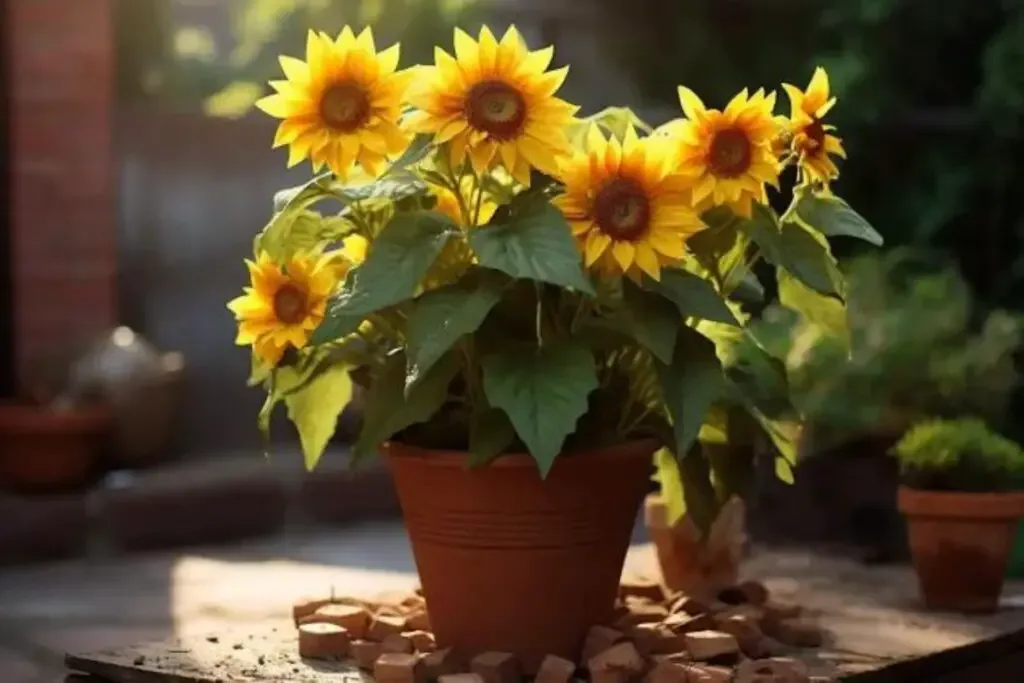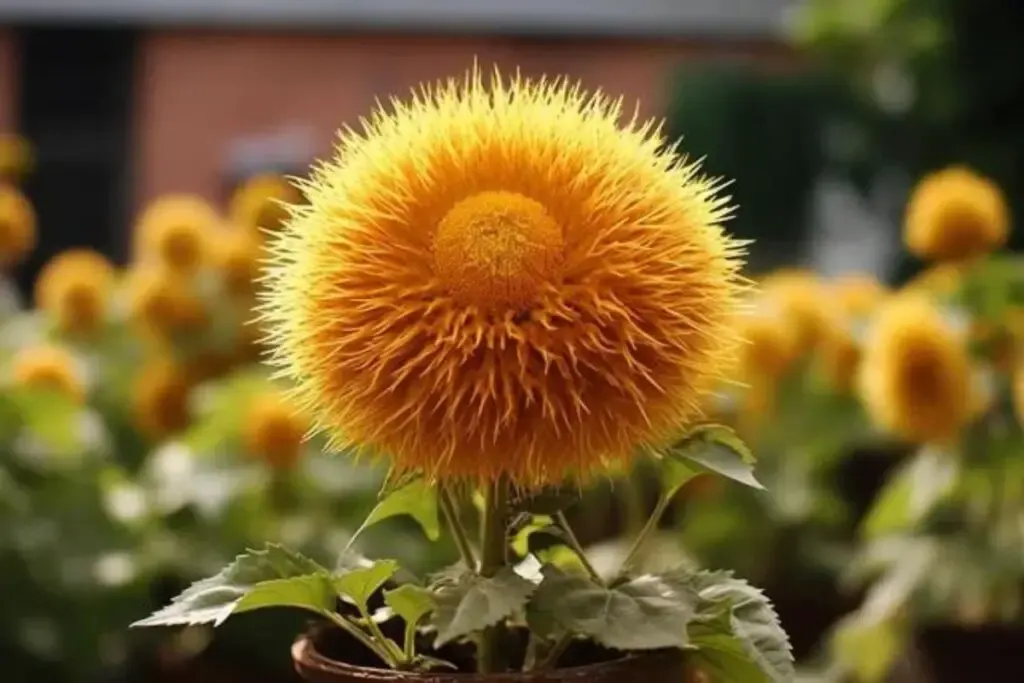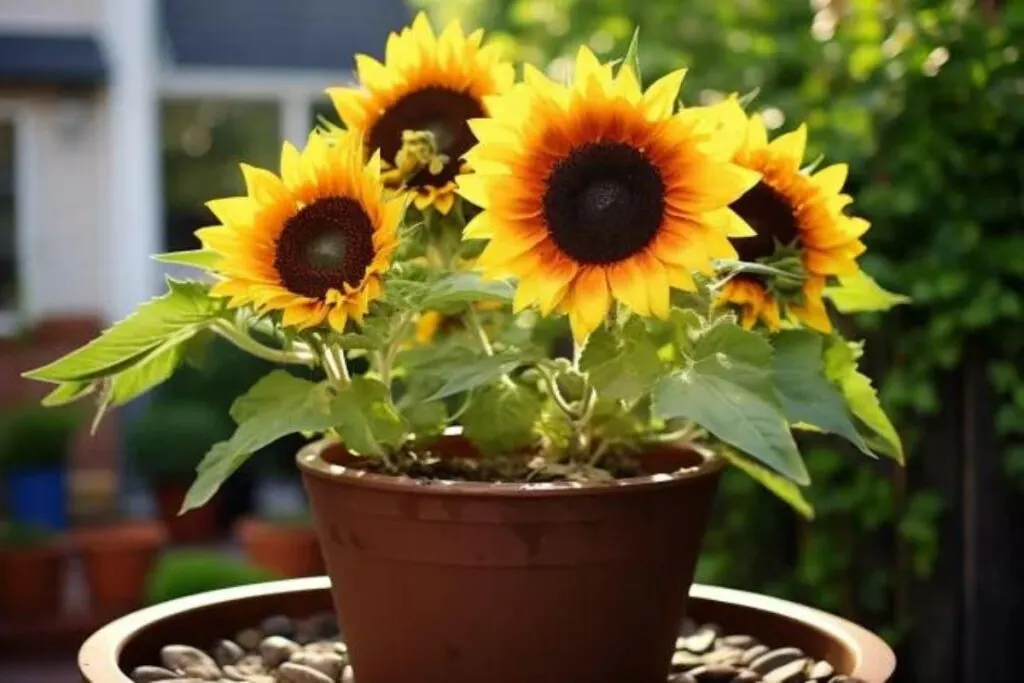Sunflowers, with their bright and cheery faces, are often the emblem of summer, evoking feelings of warmth and nostalgia.
While they are traditionally grown in open fields, reaching for the sky, many gardeners have found joy in planting these golden beauties in pots. Cultivating sunflowers in containers allows even those with limited space to enjoy these captivating blooms.
So, whether you have a sprawling backyard or a modest balcony, let’s delve into the world of potted sunflowers and turn you into a sunflower-growing expert!
Do Sunflowers Grow Well in Pots?
The simple answer is a resounding yes! Sunflowers can thrive in pots, provided they have enough room for their roots and ample sunlight to mimic their natural desire to bask in the sun’s glory.
Container gardening offers a level of flexibility for sunflower enthusiasts, as pots can be moved to catch the sun or shield the plants from strong winds.
The key to successful sunflower growth in pots lies in the size of the container and the soil quality. A deep pot with a broad base is ideal as it accommodates the sunflower’s taproot and prevents tipping, considering their height and weight.
Good drainage is crucial, so always opt for pots with drainage holes. As for soil, a nutrient-rich potting mix that retains moisture without becoming waterlogged will create the perfect home for your sunflowers to flourish.
Best Sunflower Varieties for Pots
Not all sunflowers are created equal, especially when it comes to pot cultivation. Some varieties are better suited for container life, generally the dwarf or short-statured types that don’t grow too tall, thereby avoiding the risk of becoming top-heavy.
Let’s explore a few varieties that are well-known for their container-friendly growth habits.
1. Dwarf Sunspot

Dwarf Sunspot sunflowers are a popular choice for pot gardening due to their compact size—they typically grow to be about 2 feet tall.
Despite their small stature, they produce large, classic sunflower heads that can reach up to 10 inches in diameter. The Dwarf Sunspot is ideal for those who want the grandeur of sunflowers without requiring the space for the giants of the species.
2. Teddy Bear

The Teddy Bear variety is a personal favorite of mine and a delight in any potted garden. This fluffy, charming variety grows to about 1.5 to 2 feet tall and features unique, densely petaled blooms that resemble pom-poms.
These sunflowers are not only a beautiful conversation starter but also a kid-friendly choice due to their soft, touchable texture and manageable size.
3. Music Box

Music Box sunflowers bring a medley of colors to your garden with blooms in shades of yellow, bronze, and pale lemon, often with contrasting dark centers.
This variety stays relatively short, usually under 3 feet, making it an ideal candidate for container growth. The Music Box’s multitude of blooms on branched stems provides a longer-lasting display, perfect for those who appreciate a prolonged bloom period.
How to Grow and Care For Sunflowers in Pots
Successfully growing sunflowers in pots is not just about the initial planting—it’s a journey. With the right care and attention, your sunflowers will grow strong and provide a stunning visual impact.
Let’s break down the essential steps for optimal growth and care.
Planting
The first step is planting your sunflower seeds. Start with a clean pot and fresh potting mix. Sow the seeds about an inch deep into the soil, and gently water them.
If you’re planting multiple seeds in one pot, space them out by at least 6 inches to give each one ample room to grow. Sunflowers typically germinate within 7 to 10 days. Remember, they don’t transplant well due to their deep taproots, so it’s best to start them in the pot you plan to grow them in.
Pot Size
Choosing the right pot size is critical for sunflowers, especially considering their potential height and large root systems.
A minimum 12-inch pot is suitable for dwarf varieties, but if you’re growing a taller type, you’ll need a pot that’s at least 18-24 inches deep and wide. A sturdy material like terracotta or heavy-duty plastic is ideal to support the sunflower’s weight.
Light
Sunflowers are aptly named for their love of sunlight. For optimal growth in pots, they require a generous amount of daily sun—ideally, 6 to 8 hours of direct sunlight. In my own potted sunflower garden, I make sure to place the pots in the brightest, sunniest part of my space.
If you’re in an area with less intense sun, don’t worry; sunflowers are quite adaptable. Just remember, the more sun they receive, the better they’ll grow and the brighter they’ll bloom. Rotating the pots occasionally ensures that each side of the plant gets an equal share of sunlight, promoting even growth.
Soil
The right soil is crucial for growing healthy sunflowers in pots. These plants prefer well-draining, nutrient-rich soil. I recommend using a quality potting mix combined with a bit of compost or well-rotted manure for an extra nutrient boost.
Sunflowers aren’t too picky about soil pH, but they do need soil that can hold moisture without becoming waterlogged. Proper soil preparation ensures your sunflowers have a strong foundation for robust growth.
Water
Sunflowers in pots may require more frequent watering than those in the ground. The soil should be kept moist but not soggy.
During the peak growth season, you might need to water your sunflowers daily, especially in warmer weather. However, be cautious not to overwater, as standing water can be detrimental to the plant’s health.
Temperature and Humidity
Sunflowers are quite hardy and can tolerate a bit of variation in temperature and humidity. They thrive in temperatures between 70 to 80 degrees Fahrenheit but can handle a little higher or lower as well.
Humidity isn’t usually an issue, but if you live in an exceptionally dry climate, a light misting in the morning can help the plant feel more at home.
Fertilizer
Fertilizing your potted sunflowers can greatly enhance their growth and bloom. Sunflowers are heavy feeders, so I suggest using a balanced, slow-release fertilizer at the time of planting.
As they grow, you can supplement with a water-soluble fertilizer every few weeks, especially during the peak growing season.
Be mindful not to over-fertilize, as this can lead to more leaves and fewer flowers. The key is to provide consistent nutrition to support both the growth of the stalk and the development of the vibrant sunflower heads.
Pruning Potted Sunflowers
Pruning is a step often overlooked when growing sunflowers, but it can be a beneficial practice to encourage more blooms and maintain a tidy appearance.
For the most part, sunflowers are low-maintenance and do not require intricate pruning. However, deadheading, which is the removal of spent flowers, can encourage additional blooming.
To deadhead, simply snip off the flower head after the petals begin to wilt and before the seeds start to form. This redirects the plant’s energy from seed production back into growth and new blooms. Also, if you notice any damaged or diseased leaves, remove them promptly to prevent the spread of disease and improve air circulation.
Remember, the goal of pruning your potted sunflower is not to reshape it but to optimize its health and flowering potential.
Overwintering
Most sunflowers are grown as annuals, meaning they won’t survive the winter to regrow the next season. However, if you are growing a perennial variety or wish to preserve your annual sunflowers’ seeds, overwintering becomes relevant.
For perennial sunflowers, reduce watering in the fall to allow the plant to harden off. As the foliage dies back, you can trim it down, leaving about 6 inches of stem above the soil. Move the pot to a sheltered location, like a garage or shed, where it’s cool but frost-free.
Check on the soil occasionally—it should stay barely moist but not wet. For annual sunflowers, you can harvest the seeds in the fall once the flower heads are brown and dry. Store the seeds in a cool, dry place and replant them the following spring.
If you live in a mild climate, some annual varieties may self-seed if the flower heads are left on the plant and allowed to drop seeds. However, for more predictable results, collecting and replanting the seeds is your best bet.
By following these overwintering steps, you can ensure that your love for sunflowers continues year after year, with every season bringing a new opportunity to grow these joyful blooms.

